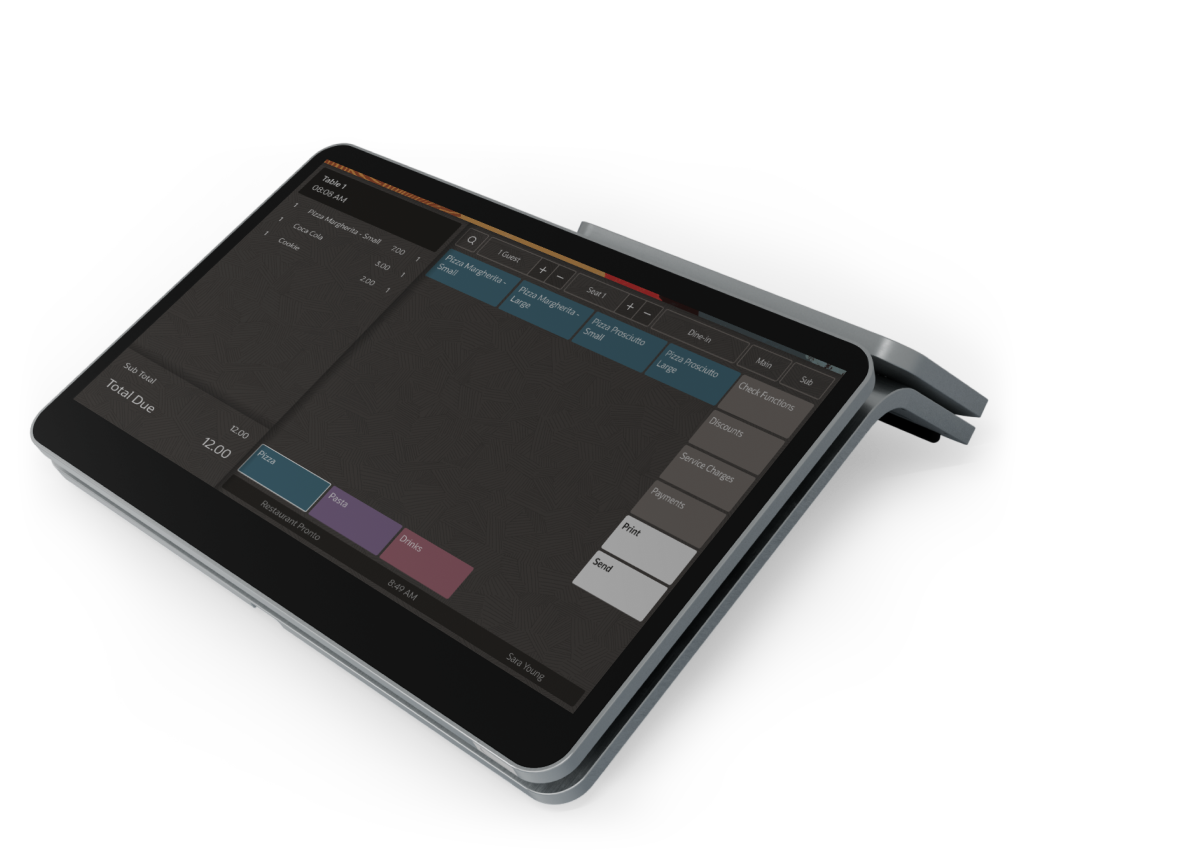A small ice cream shop business plan is an important document outlining your shop’s unique concept, target market, operational details, marketing strategies, and financial projections to attract investors or secure funding.
Key sections include:
- An executive summary
- Company overview
- Market analysis (identifying competitors and trends)
- A detailed product and service plan for your menu
- A strategic marketing and sales plan
- A comprehensive operations plan (including location, equipment, and staffing)
- A section on the management team
- And a realistic financial plan with startup costs and revenue projections.
Even with its minimal risk of entry, the ice cream industry is extremely competitive and highly susceptible to the seasons. For this reason, it is important to have a meticulous plan to avoid failure.
The following article outlines the steps that should be taken when writing a small ice cream shop business plan. Examples are included to illustrate how each section can be developed.
What is a business plan?
A business plan is a document that helps you set goals for your business, and plan how you’re going to reach them.
If you’re planning on opening an ice cream shop or scaling up your existing parlour, careful planning and organized preparation are critical.
A business plan acts as the roadmap that outlines your operations, attracts investors, and details your plan for growth.
What should your small ice cream shop business plan include?
The content and structure of your small ice cream shop business plan should include anything that will help you use it effectively. That being said, there are some key sections that should be included and that investors or bankers will expect to see.
1. Executive summary
This section should include an overview of the ice cream shop concept. This means that you need to detail the type of shop you want to open, for example:
- Ice cream parlor
- Ice cream truck
- Ice cream kiosk
- Artisanal ice cream shop
This is where you would also list your:
- Mission statement and vision – Your mission statement should be a brief summary of your values, purpose, and daily goals. Your vision statement should outline your desired short and long-term goals.
- Key business highlights – In this part, you should list your unique selling point, what makes you different from your competitors, and target customers.
- Financial snapshot – Here, you should state your startup costs, revenue projections, and break-even point.
Ice cream shop executive summary example:
Pronto Ice Cream Shop is a community-focused dessert shop offering handcrafted, high-quality ice cream made with locally sourced ingredients. Our mission is to create memorable experiences by serving unique flavors in a welcoming environment. Our vision is to become the go to neighborhood destination for families and friends while expanding through catering and online ordering.
Led by John Smith, an experienced entrepreneur, with support from a skilled culinary and marketing team, Pronto Ice Cream is positioned to deliver both customer satisfaction and sustainable growth. A target of $150,000 in revenue is projected in the first year, with steady growth expected through seasonal ice cream promotion ideas and community partnerships.
2. Business description
In this section, you need to give a detailed description of what your company does. Specifics will need to be given, so go into detail about the problems your business solves.
Explain the things that will make you better than your competitors and how you plan to stay relevant in this industry.
You should also list
- The type of ice cream shop you plan to open – Ice cream comes in many fun forms. What type of ice cream shop will you open? Traditional parlour, gelato shop, frozen yogurt, vegan/dairy-free focus.
- Ownership and legal structure – Who has ownership stakes in the business? Is it going to be a sole proprietorship, partnership, or LLC? If you plan to open the business with another individual, then everyone’s role should be clearly defined.
- Location strategy – Where will your business be located? Downtown, mall, tourist spot or near schools? When deciding on your location, keep in mind that ice cream shops in high foot traffic areas tend to generate more sales.
- Unique concept – What makes your ice cream shop different? Is it homemade flavors, seasonal specials, premium ingredients, or fun themes? List the items on your menu that are unique to your business. If you plan on hosting special events like ice cream pairing night, they should be listed here.
Ice cream shop business description example:
The shop will be organized as a limited liability company. A focus will be placed on dairy-free and low-sugar options, positioning the business as a healthier alternative to traditional ice cream outlets. The shop will be strategically placed on the ground floor of “The Mall” close to the main entrance.
3. Market analysis
Here is where you would look at things like customers, pricing, competition, and market size.
Market research should be conducted to understand customer preferences, competition, and industry trends.
You should include the actual size of the market you want to serve, and the prices your customers are willing to pay. Data should be collected through surveys, online research, and competitor visits.
In this section, you also need to perform a SWOT analysis. A SWOT analysis is an in-depth look at your small ice cream shop’s strengths, weaknesses, opportunities, and threats:
- Strengths: Positive internal characteristics that give your ice cream shop an advantage over competitors.
- Weaknesses: Negative internal qualities that put your business at a disadvantage. Where could things go wrong?
- Opportunities: Favourable external factors that your business can use to grow. Why is now the right time to launch your ice cream shop?
- Threats: Adverse external factors that could pose a threat to your business’s success. Competition and market changes that could impact your restaurant’s success.
Example of a Market Analysis section for a small ice cream shop business plan:
Research has shown that 35% of residents in the area are interested in plant-based desserts. Three competing shops were identified within a 5-mile radius; none of them currently offer dairy-free sorbet options. Research has also shown that customers are willing to pay between $3 – $4 for a single scoop of traditional flavors and between $5 – $6 for a single scoop of seasonal ice cream.
Strengths
- Unique product offerings: Ability to serve artisanal flavors, seasonal specials, and dietary-friendly options (vegan, dairy-free, low-sugar).
- Community appeal: Ice cream is widely loved and can attract families, children, and young adults.
- Low entry barriers: A small shop requires less startup capital compared to full-service restaurants.
- High impulse purchase factor: Customers often buy ice cream spontaneously, especially in high-traffic areas.
- Flexibility in operations: Can operate year-round with creative menu changes (e.g., hot desserts, milkshakes, coffee in colder months).
Weaknesses
- Seasonality of demand: Sales tend to drop in colder months unless alternative products are offered.
- High perishability: Ice cream and toppings require careful storage, leading to potential waste.
- Limited seating capacity: Small shops may struggle with customer turnover during peak times.
- Dependence on location: Foot traffic and visibility are critical to success; a poor location reduces sales potential.
- High competition: Competing with both local shops and large chains can put pressure on pricing and branding.
Opportunities
- Growing demand for healthier options: Expanding into sugar-free, organic, or plant-based ice cream markets.
- Digital ordering & delivery: Using online platforms like GloriaFood to increase reach beyond walk-in traffic.
- Catering & events: Supplying ice cream for birthday parties, festivals, and corporate events to expand revenue streams.
- Brand partnerships: Collaborating with local bakeries, coffee shops, or food trucks for cross-promotion.
- Social media marketing: Using Instagram, TikTok, and Facebook to showcase visually appealing products and attract younger customers.
Threats
- Weather dependency: Prolonged cold or rainy seasons may negatively affect sales.
- Economic downturns: Ice cream is a discretionary purchase, so sales may drop when consumer spending tightens.
- Rising costs: Ingredients, dairy products, and energy costs (for refrigeration and freezers) can reduce profit margins.
- Health trends: Increasing consumer focus on reducing sugar consumption may impact demand for traditional ice cream.
- New competitors: Entry of other small shops, franchises, or dessert concepts in the same area.
4. Marketing and sales strategy
This section details how you will attract, engage, and convert customers. A clear plan for attracting and retaining customers should be presented. The ice cream marketing campaigns should include:
- Branding & Positioning – Create an easy to remember brand name, logo, and overall ice cream shop design that reflects your quality ingredients and your target market’s preferences. Define what makes your shop special. This could be unique flavours, fresh ingredients, gourmet options, or a focus on healthier alternatives.
- Pricing Strategy – Your pricing strategy should take your demographics into account while still maintain a profit margin. Items labelled as “premium” or “seasonal” can be sold at a slightly higher price due to the appearance of exclusivity.
- Promotions & Advertising – Promotions and advertising are a great way to entice new customers and retain existing ones. Include the following in your plan:
- Social media – Engage with customers on platforms like Instagram and TikTok by sharing high-quality photos and videos of your ice cream. Create viral challenges and run targeted ads.
- Local SEO – Optimize your online presence with Google My Business and an SEO-optimized website to ensure your shop appears in local search results and on maps for nearby customers.
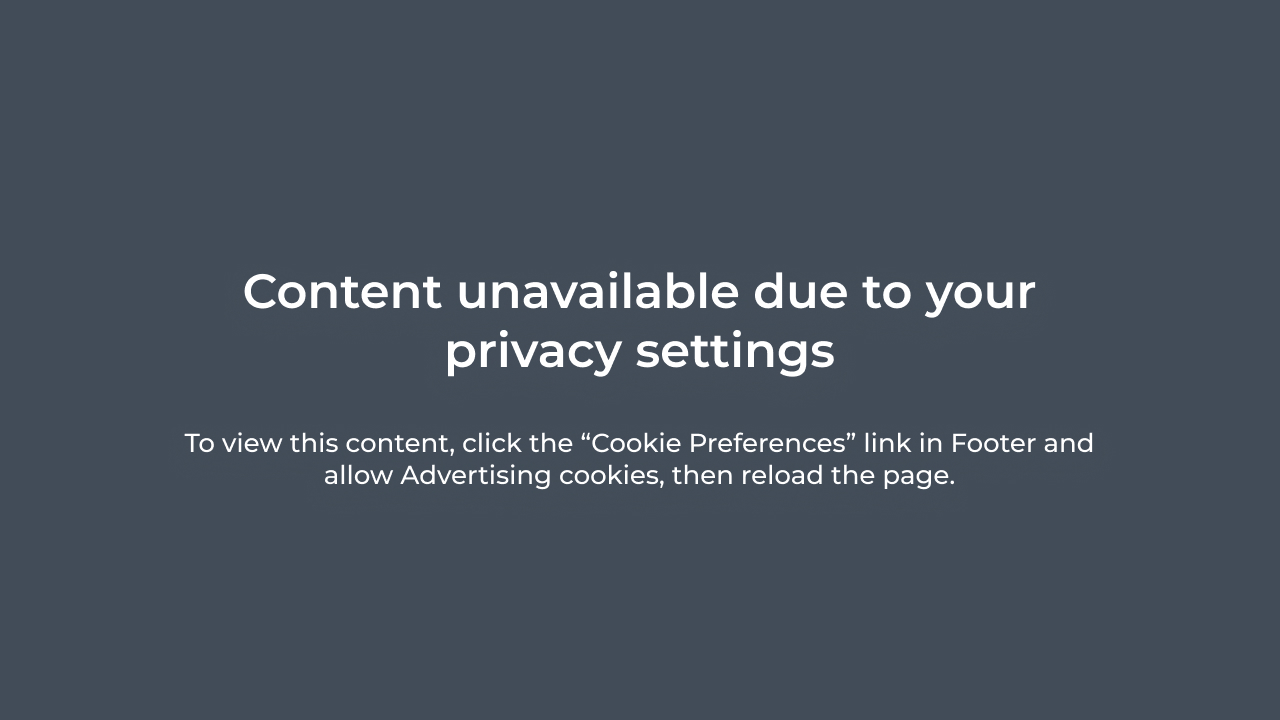
-
- Email marketing: Build an email list to send out newsletters, announce new flavours, and promote special offers to a targeted audience.
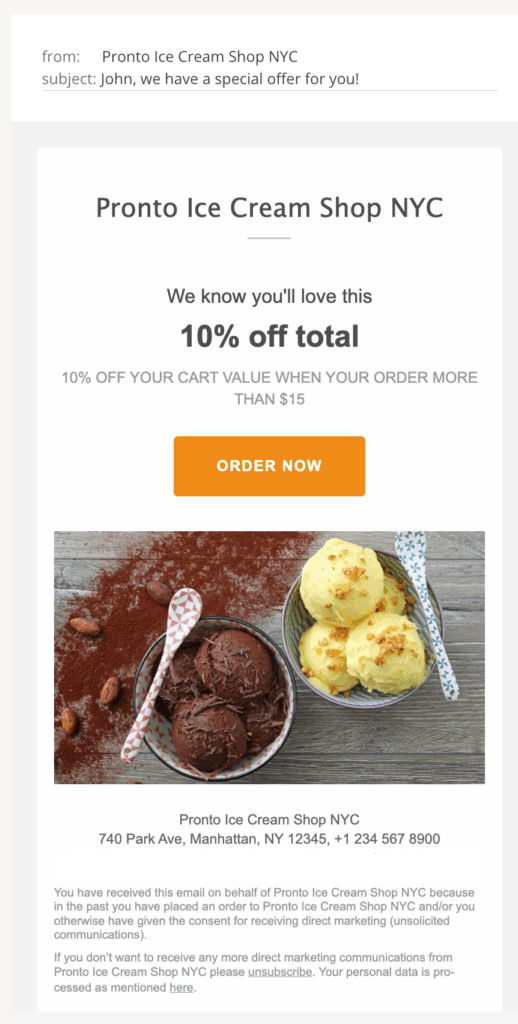
- Sales Strategies - Offer convenience to customers by providing multiple ways to purchase your ice cream:
-
- In-store: Focus on creating an inviting and memorable in-store environment. Add QR code ordering in store so that your clients can order and pay quicker, enhancing customer satisfaction.

-
- Online Orders: Add an online ordering system for customers to order directly from your website or social media pages. With GloriaFood you can allow your customers to place orders in advance so that their order is ready when they get to your shop. The process is simple, your customer places an order online and selects a date and time they would like to pick it up. All you have to do is to have the order ready when they arrive.
- Delivery Services: Create delivery zones and setup minimum order values. Then, turn your employees into delivery drivers to expand your reach. Track hotspots with delivery heatmaps to create promotions for areas where deliveries are less frequent.

- Loyalty programs – Boost repeat business and revenue by increasing a customer’s lifetime value. Loyal patrons generate word-of-mouth marketing and provide valuable customer data for targeted offers.
- Encourage repeat business – Implement a loyalty program to reward frequent customers, such as offering a free scoop after a certain number of purchases. With GloriaFood’s marketing module you can create promotions and set them up to reward customers after they have reached a certain number of orders.
- Personalized experiences – Use customer data from your ice cream shop analytics to offer personalized promotions and build stronger customer relationships.
Example of an ice cream shop marketing and sales strategy:
Online ordering will be enabled to expand the customer base. A social media marketing campaign will be created for a pre-launch buzz. We will provide a delivery service to sell our prepackaged tubs of ice cream. The marketing and sales strategy will focus on attracting customers through community engagement, seasonal promotions, and digital outreach. A loyalty program will be introduced where every 10th ice cream is free. Seasonal flavours such as pumpkin spice in autumn and peppermint in winter will be launched to encourage repeat visits. Social media campaigns and local partnerships will strengthen brand visibility. Competitive pricing and online ordering will broaden accessibility, while catering for events will provide an additional revenue stream. Sales growth will be supported by upselling combos, cross-promotions with local businesses, and consistent customer service that encourages word-of-mouth referrals. This multi-channel approach will build a loyal customer base and sustain revenue throughout the year.
5. Operations plan
This section should demonstrate how the small ice cream shop will run smoothly and consistently. Your operations plan should cover your:
- Ice cream shop location – Here, you would detail the specific location of your shop.
- Ice cream shop layout plan – Describe the shop’s design, including the customer area, service counter, seating, and any production space.
- Staffing needs – Identify the number of employees and key positions needed. Define the specific duties for each staff member.
- Daily processes for serving customers – Describe typical daily activities, such as opening and closing procedures. Explain how you will track performance and ensure quality standards are met.
- Sourcing ingredients from suppliers – List the suppliers for your ingredients, cones, and packaging. Then, explain how you will procure and receive these supplies.
- Ice cream shop equipment list – List all the equipment needed for a smooth operation, such as:
-
- freezers
-
- mixers
-
- display cases
-
- ice cream shop POS system
When choosing a POS system for your ice cream shop, you want to ensure that it has all of the below features:
- An advanced, sales-focused layout & color-coded menu categories that enable quicker order input & payment processing.
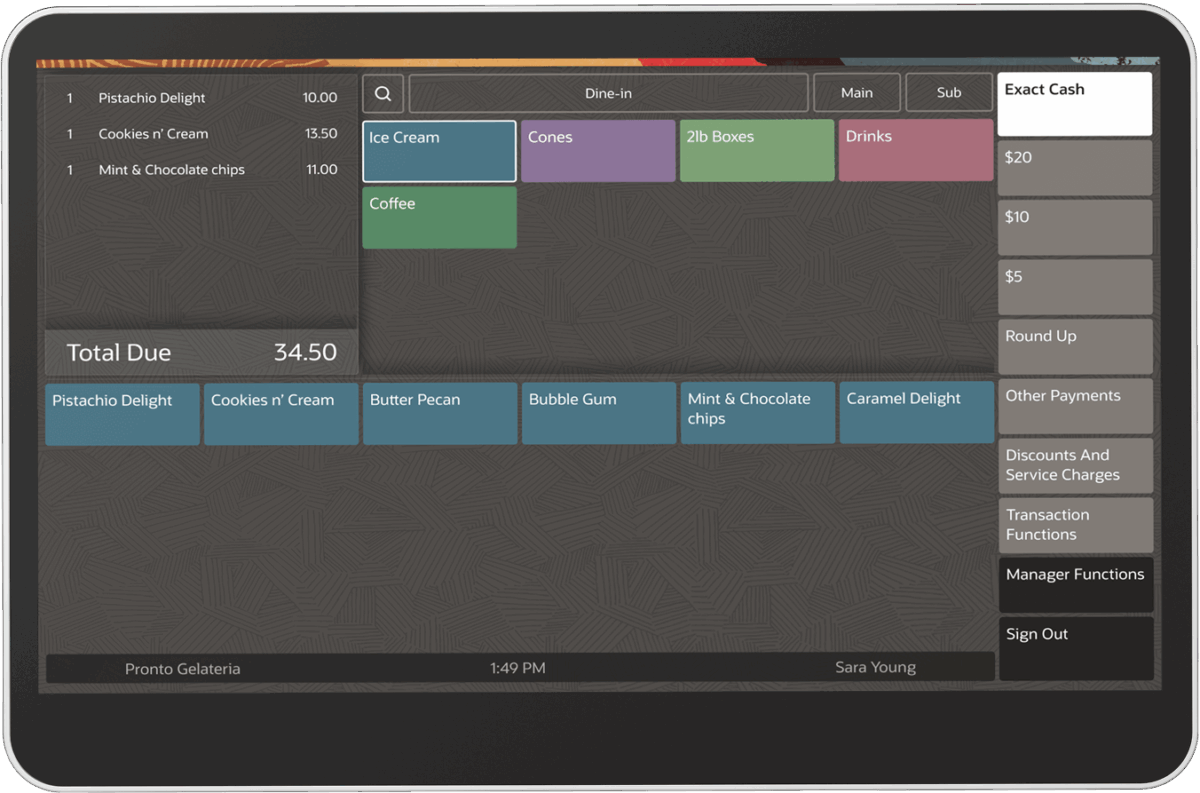
- POS gestures that allow you to quickly edit customers’ checks.
-
- Swipe to the left or to the right to delete an item from the check
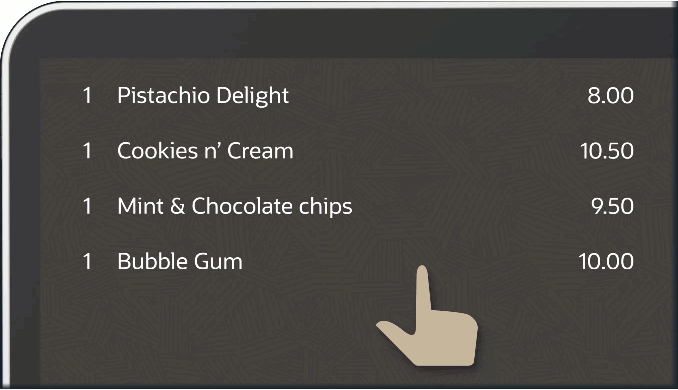
Build a plan that works in the real world
Use a proven business plan structure to attract customers and investors
Get started-
- Click the quantity of a menu item in the check detail to increase the number by 1.
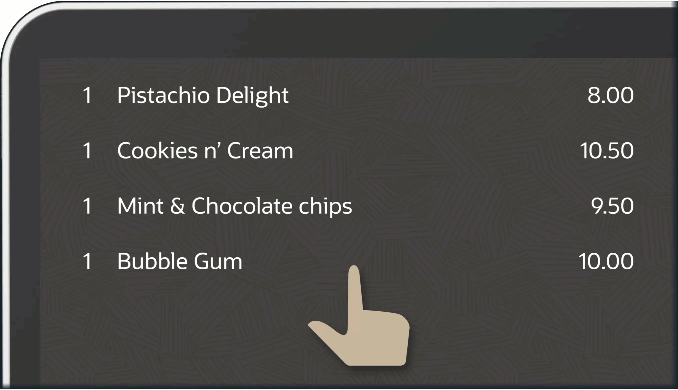
-
- Perform a long click (long hold) to reset the quantity to the original value.
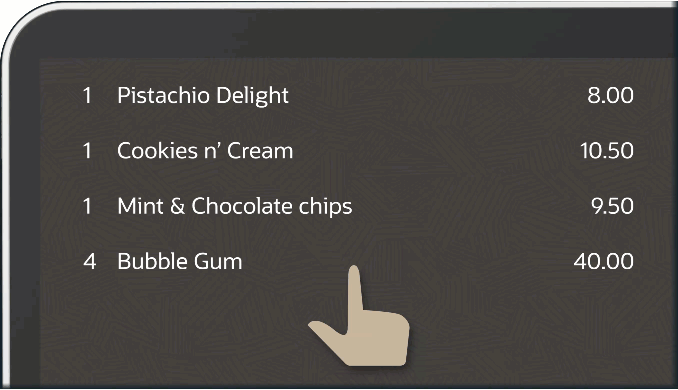
- A state-of-the-art payment device that enables you to accept debit or credit card, smartwatch or mobile payments.

- Easy tipping options for great service. You can set your own fixed tipping percentages or a fixed dollar amount.
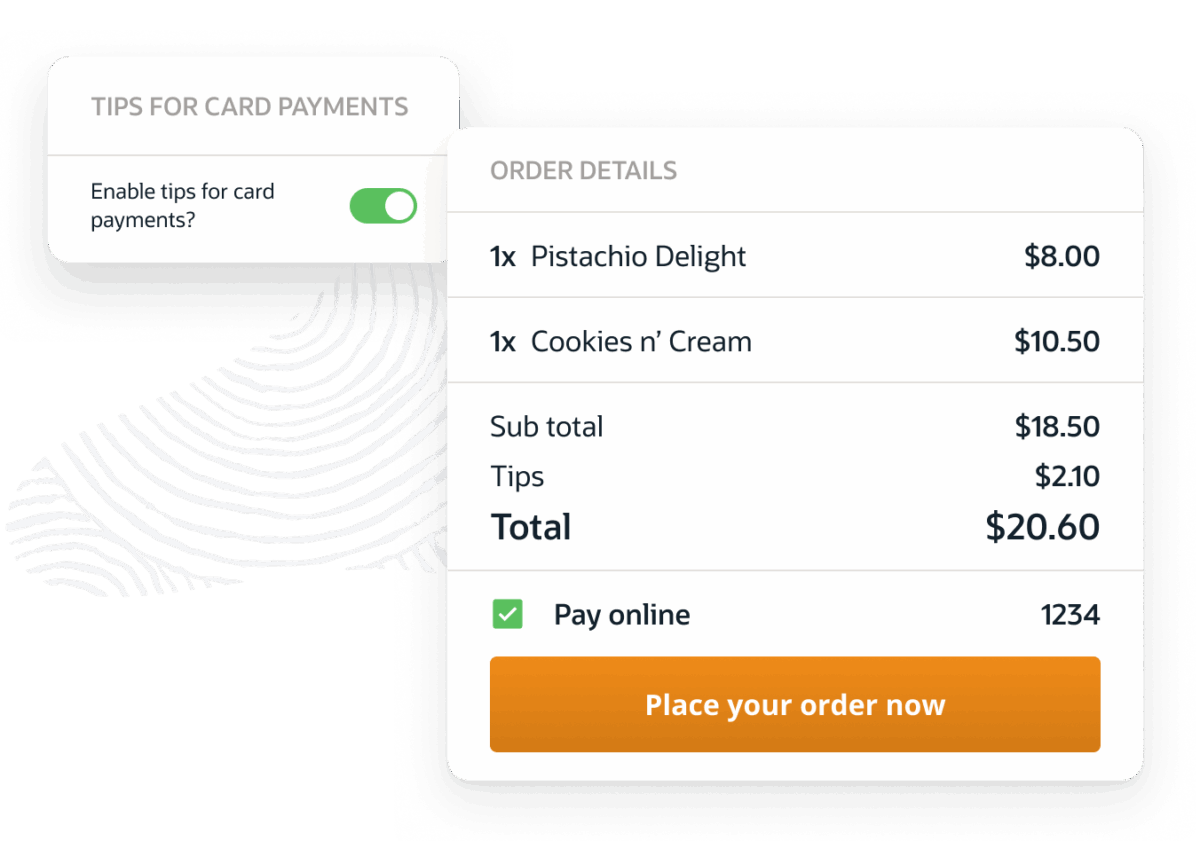
- Offline Mode: No internet? No problem! Offline mode allows you to take orders and payments with no internet connectivity. When the connection is restored, the locally stored data will be automatically synced with the cloud.
- Easy stock tracking so you can hide items from your menu or mark them as out-of-stock in seconds.
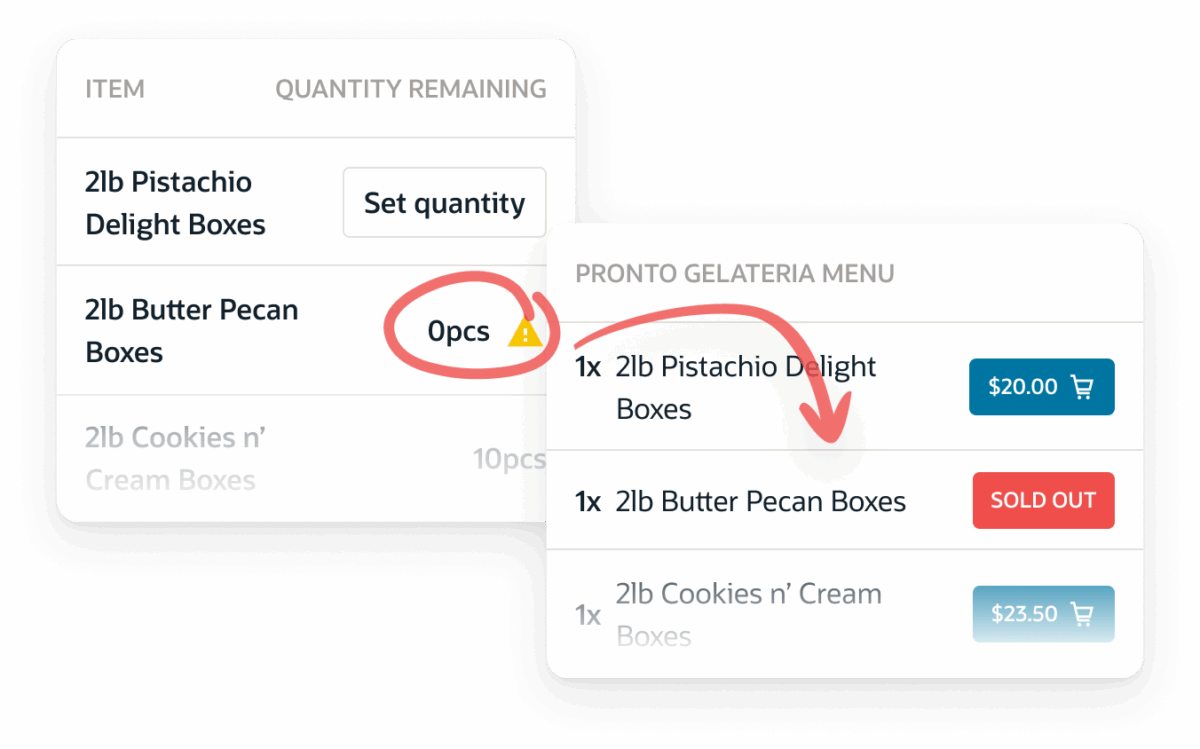
- An insightful restaurant analytics module that tells you how your business is performing & helps you increase sales.
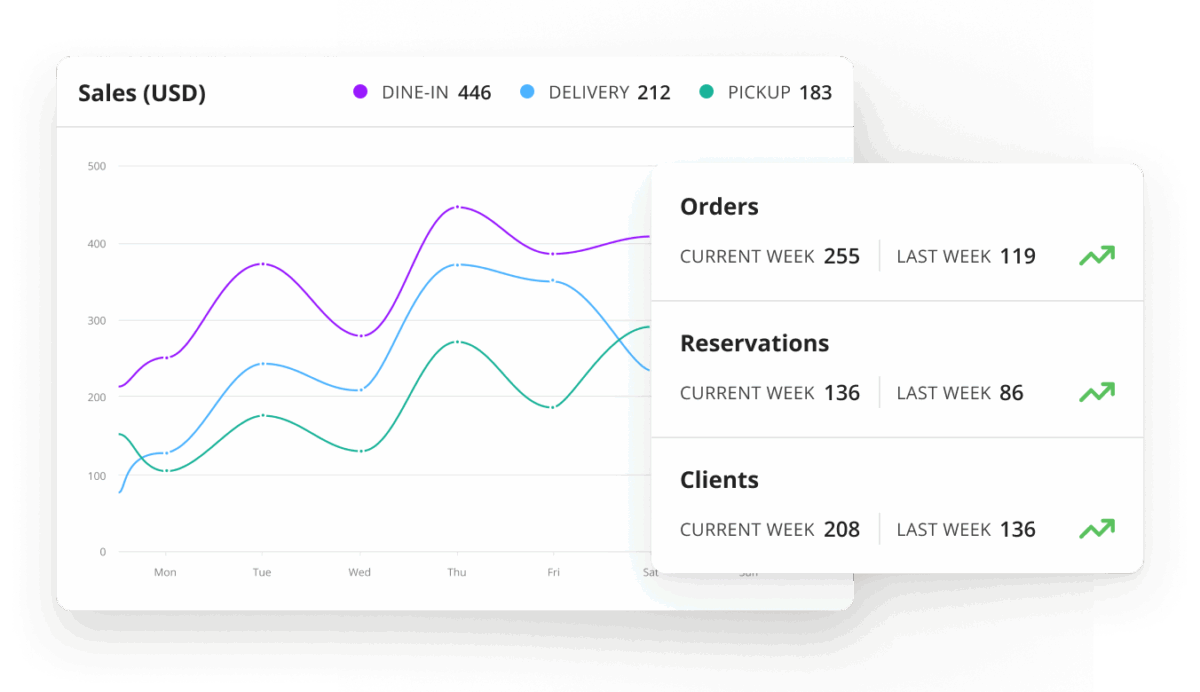
Example of an Operations plan:
Daily operations will be managed with a focus on efficiency and quality. Ice cream will be produced in small batches using commercial equipment to ensure freshness. A team of two full-time staff and two part-time employees will handle production, customer service, and cleaning.
Suppliers will be local farms and distributors to maintain consistent inventory. Standard operating procedures will guide food safety, hygiene, and customer service practices.
Technology such as an ice cream shop POS system will streamline ordering and track sales. Regular staff training and inventory checks will ensure smooth operations, cost control, and a reliable customer experience.
The shop will be designed with the POS machines in the middle, with two display counters on either side. The back-of-house area will feature a glass window so that customers can get a glimpse of how their ice cream is made.
6. Management and organization
This section of your business plan should detail your company’s internal structure and the key people who will run it. It should include:
- Employee’s qualifications and roles
- Organizational chart
- Legal structure (e.g., LLC, Corporation)
- Ownership information
- Biographies of key management personnel.
This section demonstrates your team’s capabilities, the clarity of the business’s structure, and the feasibility of its operational plan for investors and stakeholders.
Example of a management & organization section for a :
Ownership and Legal Structure
The business will operate as Pronto Ice Cream Shop LLC, a limited liability company registered in [City, State]. The LLC structure has been chosen to protect the owner’s personal assets while allowing for flexible management and potential future expansion. John Smith will serve as the sole managing member, retaining full ownership of the company.
Owner Biography – John Smith, Founder & General Manager
John Smith is the founder and general manager of Pronto Ice Cream Shop. He brings over ten years of experience in the food and beverage industry, with a strong background in hospitality management and entrepreneurship. Prior to launching Sweet Haven, John worked as an assistant manager at a popular dessert café, where he gained hands-on experience in staff supervision, cost control, and menu development.
John earned a bachelor’s degree in business administration from State University and has completed specialized coursework in small business management and food safety. His passion for creating unique, high-quality ice cream flavors was inspired by family traditions of homemade desserts, which he now channels into the business. His leadership style emphasizes customer service excellence, community engagement, and staff development.
Key Management Team
In addition to the owner, Pronto Ice Cream Shop will be supported by a small but highly qualified team:
- Sarah Lopez – Assistant Manager
Sarah Lopez holds a diploma in culinary arts and has five years of experience working in bakeries and coffee shops. Her expertise lies in recipe development, kitchen operations, and quality assurance. At Pronto Ice Cream Shop, Sarah will oversee day-to-day production, ensure food safety compliance, and assist in staff training. She will also contribute to seasonal menu innovation, drawing on her creative culinary background.
- David Carter – Marketing & Customer Relations Coordinator
David Carter has a bachelor’s degree in marketing from City College and three years of experience in digital marketing for small local businesses. He specializes in social media management, community engagement, and promotional campaign design. At Pronto Ice Cream, David will manage all customer engagement initiatives, from loyalty programs to event planning, and will develop marketing strategies to increase foot traffic and online sales.
Staffing Plan
The team will initially consist of the owner, two full-time employees (Sarah and David), and a small group of part-time scoopers hired seasonally to manage customer demand during peak months. Staff will undergo training in customer service, point-of-sale operations, and health and safety compliance.
7. Financial plan
A financial overview should be provided when writing your small ice cream shop business plan. This section is essential for attracting investors or securing loans
and should include:
- startup costs
- revenue projections
- break-even analysis
Example of a financial plan for a small ice cream shop:
Startup costs are estimated at $65,000, including leasehold improvements, equipment, and initial inventory. Monthly expenses are projected at $12,000, with a break-even point expected within the first 14 months.
8. Appendix
An appendix in a business plan is like the “supporting evidence” section. It doesn’t repeat the main content, but it provides detailed documents, data, and materials that back up the claims made in the plan.
For a small ice cream shop business plan, the appendix should include any materials that strengthen credibility with investors, lenders, or partners. It should include documents such as:
Financial documents
- Detailed financial projections (income statements, cash flow, balance sheets).
- Break-even analysis worksheets.
- Start-up cost estimates with supplier quotes.
- Copies of funding requests or loan applications.
Market research & analysis
- Demographic data of your target market (age, income, lifestyle trends).
- Local competition analysis charts.
- Industry reports on ice cream and frozen dessert consumption.
Menu & product information
- Sample menu with pricing.
- Photos or mock-ups of ice cream products.
- Descriptions of seasonal or specialty flavours.
- Supplier and ingredient sourcing details.
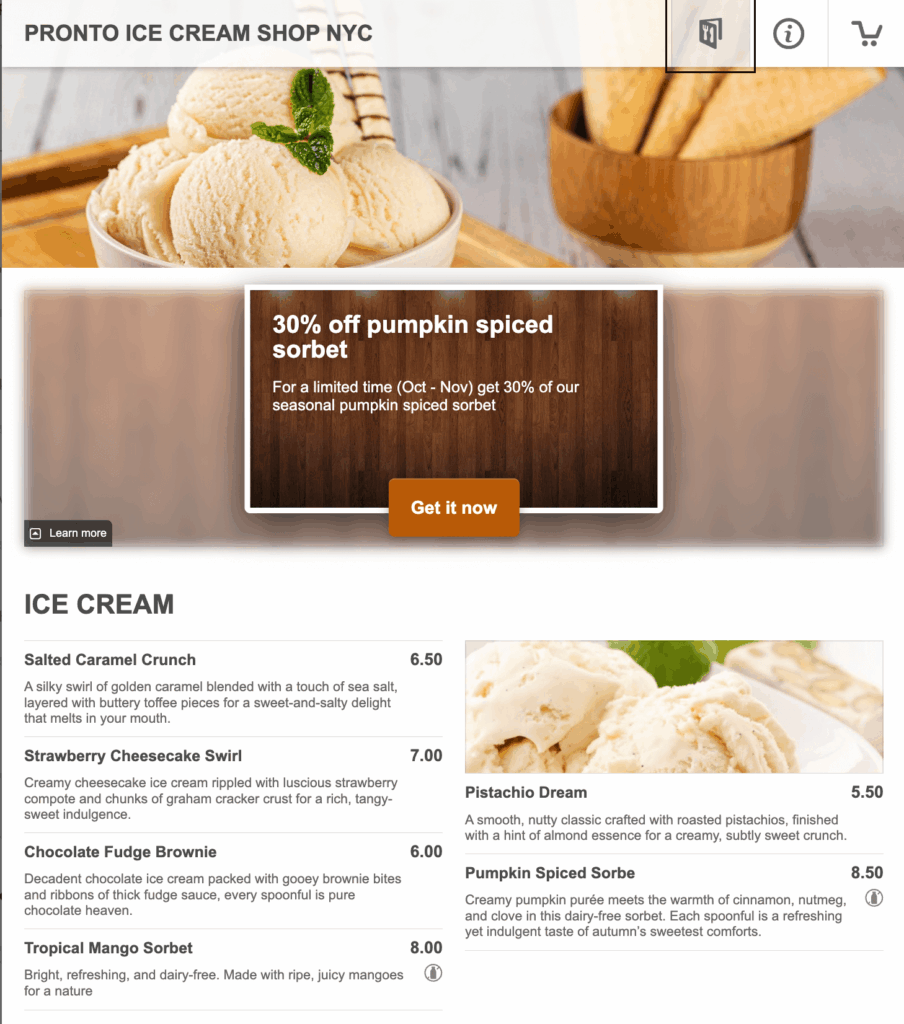
Marketing materials
- Branding samples (logos, colors, design mock-ups).
- Example social media posts or ad creatives.
- Drafts of promotional flyers or loyalty program designs.
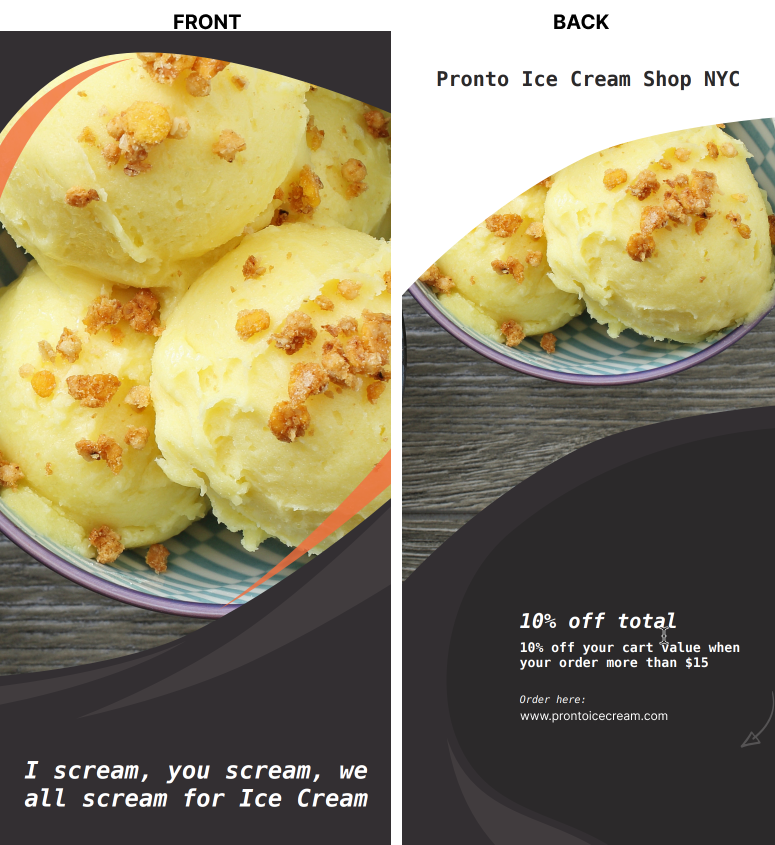
Operational documents
- Proposed floor plan or shop layout.
- Ice cream shop equipment list with supplier quotes.
- Ice cream shop POS details.
- Staffing plan, including sample job descriptions.
Wrapping Up
A well-structured small ice cream shop business plan serves as a guide for the owner and demonstrates the viability of the business to lenders and investors. Preparing a detailed plan reduces risks and leads to success.
- How to Open an Ice Cream Shop in 10 Sweet & Easy Steps
- Ice Cream Shop Menu Ideas for 2025
- Ice Cream Shop Floor Plan to Increase Efficiency & Sales
- How to Open a Frozen Yogurt Shop: A Comprehensive Small Business Guide
- Your complete restaurant POS system Guide: How to Choose the Best Option for You
- Front of House vs Back of House & How to Improve Communication Between the Two
Set your shop up for long-term success
Learn how to budget, plan operations, and grow sustainably
Get startedFrequently Asked Questions
An ice cream parlor can generate a profit margin of 20-50%, depending on operating costs, menu pricing, and customer foot traffic. Successful parlors often see steady income during peak seasons.
Opening a ice cream shop requires careful financial planning, as costs vary greatly depending on the chosen business model.
A business plan is necessary because it acts as a roadmap that defines objectives, strategies, and financial expectations. It is also required by most lenders and investors as proof that the business idea is viable. Without a plan, important factors such as seasonality, competition, and costs may be overlooked.
A complete plan usually includes:
- Executive summary
- Business description
- Market analysis
- Marketing and sales strategy
- Operations plan
- Management and organization
- Financial plan
- Appendix
Each section serves a distinct purpose and ensures that no aspect of the business is left unaddressed.
The executive summary should be brief yet informative. It should include the shop’s:
- Mission statement
- Vision statement
- Unique selling point,
- Key financial highlights
Since it is often the first section read by investors, it must be clear, persuasive, and limited to one to two pages.
The business description should explain the concept of the shop, ownership structure, location, and the value proposition that makes it different from competitors.
It should describe the type of ice cream offered, such as artisanal, dairy-free, or low-sugar options, and the customer segments being targeted.
Market research can be conducted by:
- Studying local demographics
- Running surveys
- Reviewing industry reports,
- Analyzing competitors.
Foot traffic patterns near the planned location should be observed. Online tools can be used to identify search trends for desserts in the area. Competitor pricing and product offerings should also be documented to find market gaps.
Get your restaurant POS system
More than [[restaurants_number]] customers have advanced their restaurant businesses with GloriaFood
